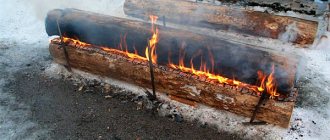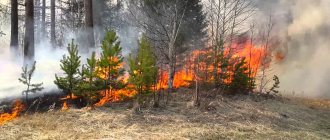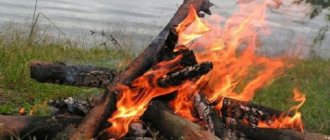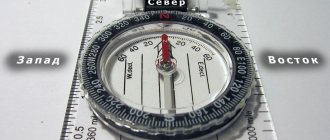Spring has arrived, which means it's time to go outdoors. What can you do to have fun in nature, besides a field kitchen and setting up a camp? We invite you to try several ways to start a fire without matches or lighters. It’s exciting, and most importantly, if the result is positive, you will gain invaluable experience that may be useful to you someday in life.
Every experienced hunter, fisherman, and just an avid traveler should know how to make fire without matches. This is the basis for survival in any unforeseen situation. Fire is life, and it is extremely difficult to do without it in harsh camping conditions. Matches can simply become damp, and then traditional and not so traditional methods and methods of making fire come to the rescue. Some of the methods described below have been familiar to people since ancient times, while others are modern know-how; they were invented recently and in some respects are not inferior to traditional methods of making fire. Lighting a fire without matches is a painstaking and time-consuming task. You can find yourself in the wilderness under absolutely any conditions, and only a fire can save a person.
Making fire using friction
This is perhaps the most famous and accessible way to get fire. It is long and painstaking, so you need to prepare for the fact that it will take a lot of time to get the first spark.
There are certain criteria for the success of such an event, one of which is the correctly selected wood as a rod and plank. The wood should be dry, not damp. A rod is a wooden stick that must be rotated on a piece of wood around its axis to create fire, creating the effect of strong friction.
The best types of wood suitable for producing fire by friction are walnut, cypress, cedar, willow, aspen, and pine.
It is necessary to collect the tinder into a compact pile. Don't put too much tinder on the wood base. The tinder itself is made from dry leaves or grass; it is a lightweight material that should ignite from a spark. A V-shaped hole is cut in the wooden backing and some tinder is placed in the recess of the hole. After this, the wooden rod is placed in the recess and the rod begins to rotate. To make it more convenient to rotate the rod with your hands, you need to take a wooden stick to create a rod at least sixty centimeters long. You need to press the rod onto the wooden backing very carefully, while quickly rotating it between your palms.
After a spark is obtained, dry moss, juniper, and aspen bark should be placed on the board.
Another interesting way to make fire without matches is the Fire Plow. To make fire using this method, a wooden base made of dry wood is useful, in the middle of which a recess is cut for the rod. You have to forcefully move it up and down. As soon as the tree begins to smolder, it is necessary to add tinder.
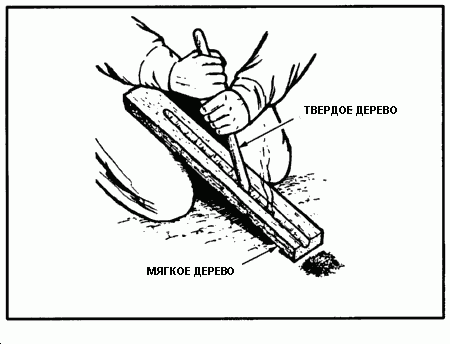
A bow drill is another versatile way to make fire without using matches. Unlike manual friction, producing a spark from a bow occurs more quickly. Since the bow maintains ideal pressure and maximum rotation speed of the wooden shaft. As a result, strong friction occurs, which helps to get fire in a short time. What is needed for this method? This is, first of all:
- Wooden rod;
- Wooden backing;
- Bow and weight;
When friction occurs, the weight is pressed onto the end of the rod, and the rod rotates with the help of the bow. In order not to break the rod, you need to use a less dense and hard weighting material.
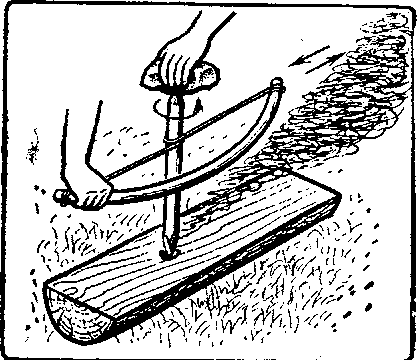
You can use water or oil as a lubricant, this will make the process go faster. Let's talk about the onion itself. You can do it yourself. The length of the bow should correspond to the length of an ordinary person's arm. It is better to choose a flexible and pliable vine; the bowstring is made from rope or shoelace. The bowstring can be made from absolutely anything, but it must be strong and not break during the making of fire. It is simply pulled over the ends of the vine branches and the bow is ready to use. A hole is cut in the wooden backing and a wooden rod is placed in the loop of the bowstring. One end of the rod should be placed in the hole in the backing, and the other in the bow string. The bow moves in a forward motion, and through this process, fire can be quickly produced. Tinder is added to the smoldering coals, and the fire slowly but surely flares up.
What can act as tinder and wick
In conditions of autonomous existence, when the issue of survival comes first, the primary task is to make fire. However, sometimes the resulting spark goes out before it has time to grow into the flame of a fire. Typically, dry paper is used to maintain the fire. If it is not at hand, the functions of the wick and tinder are performed by:
- cotton wool fluffed or smeared with petroleum jelly, cotton insulation;
- handkerchief;
- old, torn T-shirts, sheets and other rags;
- napkins, wax or toilet paper;
- cotton pads, tampons;
- dried mushroom Tinder fungus;
- wood shavings, small chips;
- old reeds, reeds, cattails, bamboo;
- Birch bark;
- dry grass;
- old dry moss;
- pine needles, fir cones;
- burnt fabric.
If you find yourself without a match or a lighter in the forest, you just need to look around and a suitable means of ignition will be found.
Some people store tinder for future use and then take it with them. Here are their recommendations:
- Store the product in sealed freezer bags. Durable products do not allow moisture to pass through, maintaining the high flammability of tinder.
- When going on a hike, transfer the contents of the bag into a special sealed container. If you leave the tinder in the bag, it will become damp and lose its value.
- Before use, fluff up and separate the material into fibers. This will speed up the formation of a spark and flame.
- Fan the tinder until it chars and full flames appear. Only then add kindling and wood.
Making fire using friction
This “non-match” method came to us from antiquity. Initially, primitive people made fire by rubbing dry pieces of wood against each other for a long time.

Later, they began to carve out a hole in the board, which was lightly sprinkled with dry leaves or grass. Then a rod-stick was inserted there and intensively rotated between two thumbs. This continued until the tinder burst into flames. To speed up the process, use the following recommendations:
- use dry wood of cypress, cedar, willow, aspen, pine, walnut;
- for more convenient rotation, use a rod 60 cm long;
- during rotation, lightly press the stick against the base board;
- as soon as the first spark appears, carefully blow on it to speed up the process;
- as soon as the contents of the recess flare up, place dry bark, moss, etc. under the board.
Important point! Without the necessary skill, it can take a very long time to get the first spark. So this method is not for the faint of heart. Making fire by friction is still used by the natives of Africa and Australia.
Fire bow and its variation
Like making fire by friction, this method requires a dry piece of wood and a stick - a rod. But the main device is the bow. By maintaining the required pressure and high rotation speed of the rod, the bow speeds up the combustion process.
The upper end of the wooden rod is wrapped with a bowstring, and the lower end is inserted into the recess and the bow is intensively moved away from you (the wooden base of the bow is perpendicular to the rod). Don't forget about tinder. As soon as it sparkles, add dry wood chips and light the fire.
It’s unlikely that anyone takes a bow on a hike, so you’ll have to build it on the spot:
- Find a flexible but strong vine (the length of the bow should correspond to the length of an adult's arm).
- Use strong rope or shoelaces as a bowstring (the main thing is that the bowstring can withstand the process of making fire).
- Pull the string over the ends of the vine.
Despite the complexity and energy consumption, in our latitudes, this method of making fire is the most preferable. There is a variation of the firebow called the "pump drill". But this method of making fire is so complicated that it is practically not used.
Making fire using lenses
To start a fire without matches, glasses, binoculars or a magnifying glass will be useful. It is enough to catch the sun's rays and direct them to the tinder, laid in the form of a pile with a hole in the center. Keep the lenses still. After some time, smoke will begin. Gently fan the fire.
Helpful tip: adding a little water to the surface of the lenses can strengthen the beam.
Using chemicals
The following chemicals are flammable when rubbed or mixed:
- Sugar with potassium permanganate in a ratio of 9:1. Sprinkle manganese on a piece of cotton wool, then sugar, rub the mixture with a stick. Within 2 minutes, the chemical tinder will ignite.
- Sugar and bertholet's salt 3:1.
- Manganese and glycerin. Sprinkle a pinch of manganese on a dry cloth, top with 3 drops of glycerin. As soon as smoke starts to appear, add a couple more drops. A bright flash will be the signal to start a fire using tinder.
- Potassium permanganate with any coolant. Sprinkle a teaspoon of potassium permanganate onto a piece of cloth, and add 3 drops of antifreeze on top. Roll up and place on the ground. Sprinkle tinder on top. The oxidation process leads to heating of the mixture and ignition of the package. Attention! Excessive dosage of antifreeze or a package that is not tightly folded will reduce the heating rate.
To prevent the search for chemicals from becoming a problem, it is better to take care of the contents of your first aid kit in advance. Bertholet's salt is part of Furacilin. And manganese crystals and glycerin are sold in any pharmacy.
No need to experiment with the ratio of ingredients. Increasing dosages will not speed up the combustion process, but will increase the likelihood of chemical burns.
Making fire using flint, steel or flint
Flint, which is the predecessor of ordinary matches, will help you start a fire in natural conditions.
Having a silicon stone on hand, you can strike a spark literally from the second glancing blow with a hammer.
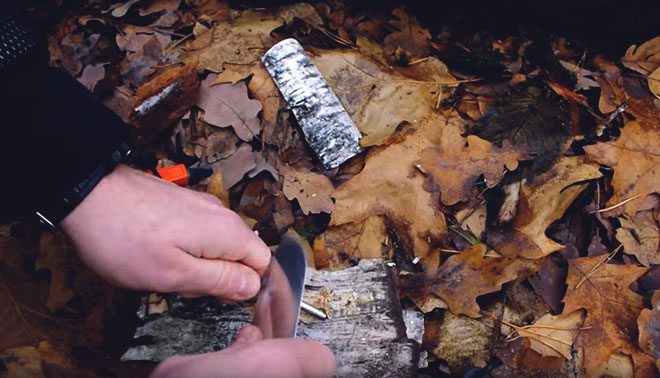
Any metal object can serve as a chair.
The role of a knife can be performed by any metal object: the back of a knife blade, an ax blade, a file. The trajectory of the falling sparks and the location of the harvested tinder must coincide.
Condom
A kind of lens is made from a condom. To do this, the contraceptive is filled with water, given its most rounded shape, tied, and the “rubber glass” catches sunlight. Focusing the beam on a pile of prepared tinder, wait until smoke appears (distance no more than 5 cm from the tinder).
Then they carefully fan the flame, add brushwood and light the fire. Instead of a condom, you can use a balloon.
Flashlight
It’s not difficult to start a fire without matches if you have a flashlight on hand that you don’t mind breaking. More precisely, break the electrical part of the light bulb. The exposed electric arc is brought to the prepared tinder and set on fire.
Skating
This method of lighting a fire without matches came to us from not so remote places. And form a piece of cotton wool into a kind of roller. Roll it intensively on a dry wooden surface until the cotton wool is saturated with oxygen and increases in volume. Oxygen will start a combustion reaction, and the material will begin to smolder.
Soda can and chocolate bar
Sweet lovers do not realize that the usual tandem in the form of a chocolate bar and a can of drink can save lives far from civilization. A clear sunny day and the following steps will help you light a fire with the help of “sweets”:
- remove the chocolate from the wrapper and rub it on the outer bottom of the tin can;
- when the polished bottom shines like a concave mirror, turn it towards the sun and set fire to the tinder spread out at a distance of 3 cm with a caught ray.
Don't be upset if you don't have chocolate on hand. Toothpaste is suitable as a polishing composition.
Wool and batteries
Making a fire without matches is not a problem if you have batteries and a cloth made of natural wool on hand (a strip 15 cm long and 1 cm wide is enough). Rub a stretched piece of fabric with a battery with a power of about 9 V.
Be patient. As soon as the smoldering process begins, blow on the wool and add dry sawdust or leaves. Hurry up, because wool doesn't burn for long.
Firearms
Empty the bullets/shot and some of the gunpowder from the cartridge, fill the cartridge case with crushed cotton wool or dried flowers and fire a blank shot at the fire site. All that remains is to fan the fire and throw the prepared brushwood into it.
Starting a fire with a silicon lighter without gas
If you have a silicon lighter that has run out of gas, the situation of losing matches is no longer critical. The first method of starting a fire requires soft and dry toilet paper. Dense and rough is not suitable. So let's get started:
- remove the protective cover;
- fold toilet paper into 5-6 layers, tear and stack the pieces so that the side of the tear faces one direction;
- in the place from which sparks are emitted when the wheel rotates, press the lighter against the stack (the sides of the gap are directed towards the sparks);
- “roll” your palm along the wheel, striking sparks on a stack of paper (repeat the manipulation until smoldering begins);
- fan until a flame appears.
If you don’t have soft toilet paper at hand, use the second method:
- remove the cover;
- loosen, knead and bend the center of a notebook or any other sheet so that a funnel is formed in the center (this is an important point, without which the task of starting a fire will become more difficult);
- place the lighter horizontally over the paper;
- be careful not to spark, and slowly turn the wheel until a sufficient amount of powder appears on the paper;
- collect a mound of powder in the loosened center of the paper;
- Turn the lighter wheel over the powder until a flash appears and the paper ignites.
Starting a fire with a concave mirror
In field conditions, the following are used as a concave mirror:
- a removed reflector from a car headlight/flashlight;
- concave bottom of the gas cylinder;
- a tablespoon deformed to the shape of a concave mirror;
- a tin can, the bottom of which is polished with a dry, rough cloth.
The “tin can and chocolate bar” method, which was described above, also belongs to this group. Accordingly, fire making is carried out according to the same principle.
Starting a fire with a nail and hammer
During the sharp impact, the metal heats up, and the high temperature spreads to the tinder. To start a fire you will need nails 10 cm long, a hammer, and an anvil.
These items are unlikely to be found in a travel backpack. This means that if you find yourself far from the city, you will have to improvise. For example: a nail is a piece of rod or other metal object; the anvil and hammer are stones (however, in this case, it is more difficult to get fire). Let's look at the procedure:
- Roll the newspaper into a tube and press it with your foot to prevent it from unwinding.
- Hit the nail lying on the anvil several times with a hammer.
- Place the heated nail against the newspaper and leave it until it begins to smolder.
- Inflate the newspaper until a flame appears.
If smoldering has not started, you need to repeat the steps from point No. 2.
Making fire using dry grass
An affordable method that has been used by foresters and rangers for many years. In addition to dry grass you will need:
- water (drinking or rain - it doesn’t matter);
- dry tree bark;
- thin and slightly thicker branches (dry);
- plastic bag;
- plenty of sunlight is the main ingredient.
Using a stone, break a piece of bark until fine tinder is formed. Then divide the particles into 2 piles and place them on two separate pieces of bark. Fill a clean bag with water and wrap it into a sphere.
All that remains is to focus the improvised lens on the sun's rays and shift the focus to the tinder. To increase the burning area, add the second part of the crushed bark and dry grass twisted into a rope.
Using a gum wrapper and a coin cell battery
Foil from a cigarette pack is suitable as an analogue of wrapper. From paper foil, cut an even thin strip that is as long as possible. Sharpen the ends with a knife and attach them to the poles of the battery. Place the sagging part of the foil on the prepared wick.
Attention! When making fire using a battery and foil, you need to take into account the rapid flammability of the method.
With ice
It would seem that there is nothing more stupid than making fire with ice. And how can you light a fire using frozen water? However, experienced travelers claim that this method is a solution for harsh winters, when you can’t even dream of dry grass or leaves.
Having found a piece of pure transparent ice, you need to give it a convex shape and apply it like a lens. The force of the captured sunlight will easily ignite paper, dry cloth or cotton wool.
If you don’t have clean ice, you can make it yourself by freezing drinking water in a shallow saucer and polishing the resulting piece with your hands until it’s transparent. The thickness of the finished lens is at least 5 cm.
Attention! This method requires skill, because the ice melts quickly.
Hand drill
The method has long been used by residents of hot countries. Fortunately, the tropical and equatorial zones are rich in suitable wood. Procedure:
- peel part of a medium-sized branch from the bark and split it into 2 parts;
- make a small slot in one half, in the narrowest part of which, on the outside, make a recess for the drill;
- a stick of medium thickness, 50 cm long, sharpened on one edge - this is a drill;
- place the stick with the slot with its flat side on the pre-prepared wick;
- rest the sharp end of the drill into the recess;
- hold the upper part of the stick between your palms and rub it intensively with rotational movements;
- The embers thus obtained fall onto the wick and are then fanned to produce a full-fledged fire.
Fire bamboo
The method is applicable in regions where bamboo grows. To start a fire in the wild, you will need dried plant stems. The procedure is as follows:
- split a meter-long bamboo trunk into two parts;
- shorten one part (No. 1) by half and make a small through hole in the middle; cut a transverse groove from the outside, right along the line of the hole;
- from the second split piece (No. 2), cut a wide sliver 40 cm long and break it in the center;
- sharpen the side part (No. 2), scrape off the finest shavings from it (it looks like twisted ribbons);
- Divide the shavings into 2 parts and roll into tight balls; then place it inside part No. 1, directly above the hole; press on top with a broken sliver;
- rest your stomach against the edge of trunk No. 2 (the second edge rests against the ground);
- Taking part No. 1 by the opposite ends (with kindling, wood chips), lean it with a groove against the sharp end of the second part;
- carry out reciprocating movements until signs of smoldering appear;
- Transfer the smoldering kindling to dry grass and fan the flame.
Accumulator battery
If you have a vehicle, the problem of losing matches ceases to be relevant. It is enough to make a short circuit between the “+” and “-” . That's it - the job is done. All that remains is to fan the spark that fell on the previously placed wick.
Making fire using lenses
We all know the standard physics course at school, from which we remember that a beam of solar energy passing through glass is concentrated at one point. The temperature is so high at this point that just holding a paper napkin to it will cause it to light up. This method of making fire is good for everyone, but there is also a significant disadvantage. You can get fire using a lens only in dry and sunny weather. What will you need?
- Lens of any type;
- Tinder collected from dry leaves or grass;
If you don’t have a lens, then regular glasses, a piece of glass, the bottom of an aluminum can, or even ice will do. By the way, you can dwell in more detail on making fire using ice. It would seem that these are two mutually exclusive concepts: ice and fire. But thanks to ice, you can light a fire, which is especially useful in winter, when it is difficult to find dry leaves or grass. The principle of operation of this interesting method was also described by Jules Verne. You need to create a lens from ordinary ice, but the ice should be as clean and transparent as possible.
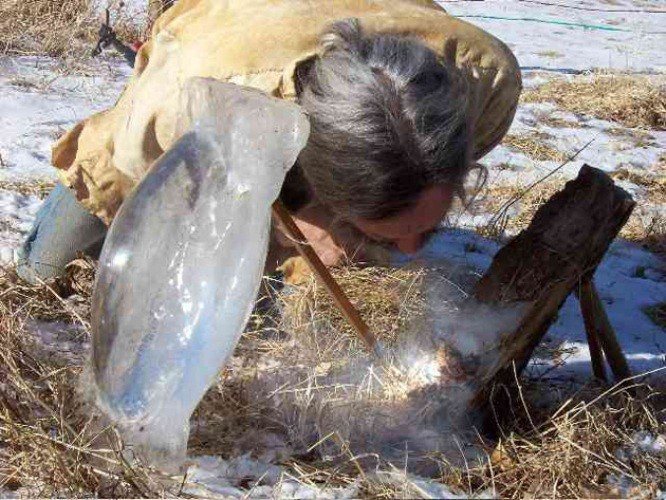
Thanks to the coordination of the sun's rays, even paper can be set on fire. It is not always possible to find pure ice in nature, but you can freeze plain drinking water. The resulting piece of ice is carefully processed and polished using improvised means. Ice can also be frozen in a spherical container, such as a shallow saucer. But you need to remove the ice as carefully as possible so as not to damage it. Ice melts quickly and such a lens should be used as quickly as possible.
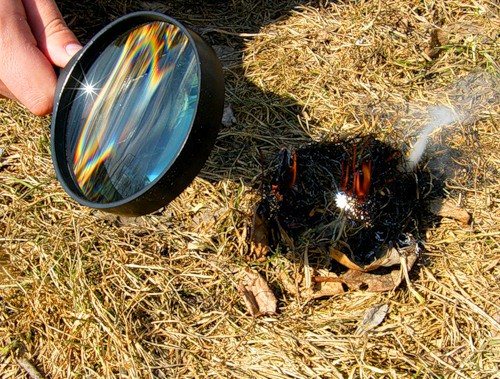
As for simple lenses, it’s enough to just take some dry twigs, leaves, grass and build something similar to a nest. After the lens is pointed at the tinder, you must carefully monitor the appearance of smoldering and smoke, and try to fan the fire.
Preparing a place to make a fire in winter
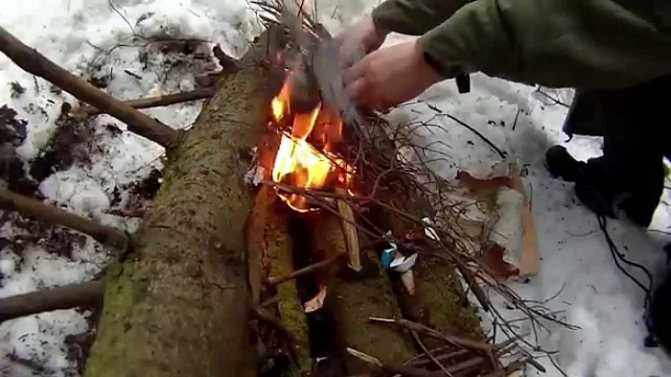
The most important step in starting a fire in winter is to properly prepare the place, since otherwise all efforts to organize a heat source will simply go out before it has time to flare up fully. In ideal conditions, you need to find a place that is not blown by the wind and protected from snow and rain.
This condition is necessary for the fire to perform its immediate functions for a longer period of time. We talked about how to light a fire in wet weather in this article.
The location of the fire is also an important factor. It is necessary to organize it in such a way that there is a minimum of unnecessary objects around it, such as paper, flammable mixtures, branches, etc. After all, we only need a fire, and not an uncontrollable fire.
It is necessary to place an overnight stay near a fire. If you sleep in a tent, it must be positioned in such a way that it protects the fire from the wind.
After choosing the optimal place, before lighting a fire, there are two preparation options: the first is to remove the layer of snow right down to the ground using any available means. It is quite logical that if you do not clear the future fireplace of snow, sooner or later it will grow, which will lead to the extinction of the flame.
The second way is to organize the fire so that it is located on logs or boards. If you use the second method, in addition to long burning, you can get heat on the sides of these logs as a bonus, which will help you warm up faster.
Making fire using chemicals
Simple knowledge of elementary chemistry will help you make fire. Some chemicals are flammable when rubbed or mixed. But when using this method, you must exercise individual caution so as not to harm yourself. It is important to prevent physical contact of the chemical with the metal surface. The following compounds promote ignition:
- Potassium permanganate (potassium permanganate) and regular sugar in a ratio of nine (sugar) to one (potassium permanganate);
- Potassium chlorate and sugar (proportions three to one);
- Potassium permanganate and glycerin;
- Sodium chlorate and sugar (proportion three to one);
- Potassium permanganate and any antifreeze;
Now the question is: where to get these chemical elements? Potassium chloride is included in some drugs against throat diseases (Furacillin). And potassium permanganate and glycerin can be found in the first aid kit. The most basic example: take a small piece of cotton wool, add potassium permanganate, then sugar and begin to rub this kind of tinder with a stick.

After a couple of minutes, the cotton wool will ignite. A common mistake made by inexperienced people is that they do not follow the correct dosage of ingredients.
Physical (friction force)
This method is the most complex and energy-consuming. To bring it to life, you will need three main elements: a simple board or stump with a shallow hole cut out, the diameter of which is approximately equal to the diameter of the stick.

The second element is an ordinary stick approximately 30 cm long, one side of which is sharpened.
Visually it resembles a pencil. The third key element is a thin branch (for example, a birch branch) about a meter long and about 3 cm thick.
Bend it a little and pull the rope. Visually reminiscent of an Indian bow.
This is interesting: Shelters and shelters: types, classification, purpose
Next, we sequentially assemble the structure: we pour a little kindling into the hole of the first element (twigs, cotton wool, paper, etc.), insert the sharp end of element two (“pencil”) into the same hole, and wrap the string of our “bow” on top. After this, we begin to move the bow back and forth.
When the flame lights up, you can throw in the main brushwood. The main thing is to first wrap your palms with a rag or tree bark so as not to develop a callus.
Making fire using flint, steel or flint
Another method, rooted in centuries-old history: making fire using flint. Flint was especially popular in the eighteenth century before the invention of ordinary matches. To strike a spark and make a fire, it is enough to have a silicon stone. A couple of blows are enough and you can bring tinder from leaves or dry grass to ignite the fire. Flint was often used in camping conditions or in war. Also, many people carry it in their EDC kits. The chair must be metal.

If you're lucky, you can make sparks for a future fire using silicon. Flint, consisting of hard rock minerals, can be easily found among stones. By the way, flint steel was used in ancient firearms.
Used lighter with flint plus cotton wool or paper
It doesn’t matter if a silicon lighter runs out of gas at the most critical moment—a flame can still be produced from it.
- You need to stock up on the same cotton wool, a napkin or a piece of toilet paper, placing them on something that burns longer, for example, on the same tablet candle, on a lump of dry grass or old dried moss.
- First, you need to remove the top metal cap, and, holding the lighter close, scratch it - sparks will fall on the tinder and cause ignition.
Therefore, do not rush to throw away a lighter deprived of gas - it can still help out by starting a fire without matches.
Condom
After we have examined the traditional and quite familiar methods of making fire without matches, we can turn our attention to alternative methods of making a flame. Let's talk about the most interesting of them. A condom is not only a means of protection, but also an excellent means of starting a fire without matches. It needs to be filled with water, the main thing is not to overdo it.
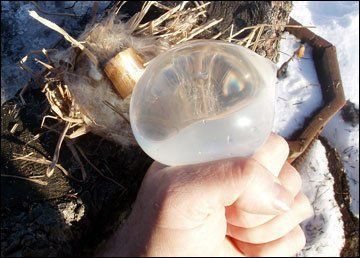
The result is something like a lens. The light from the sun passing through the condom is focused on the pre-prepared tinder on a wooden backing. As a result, the tinder begins to slowly smolder, all that remains is to fan the flames of the fire. This is such an interesting and creative way.
How to light a fire in winter? Practical advice
Not only a professional hunter or traveler, but all people should have the ability to make a fire, because it is not known in what circumstances a person may find himself. Making fire is the basis of the school of survival.
That is why next we will look at the main methods of starting a fire. Not surprisingly, they are acceptable at any time of the year.
In winter, the main difference is the preparation of a place for a fire.
This is interesting: Do-it-yourself crossbow: how to make it step by step, easily and simply
Skating
If we don't wash, we'll ride! In this case, you will need regular cotton wool. This old prison know-how consists of forming a kind of roller from a simple piece of cotton wool.

The roller begins to roll out over the wooden surface. After some time, the cotton wool begins to smolder, the cotton wool increases in size, becoming saturated with oxygen. Oxygen itself is a catalyst for the combustion reaction.
A can of Coca-Cola and a bar of chocolate.
How can these delicacies help in making fire, you ask? Everything is very simple. The ingredients for success are a sunny day, chocolate and a soda can (tin). Open the chocolate and start rubbing it on the bottom of the tin. Of course, it’s a pity for chocolate, but you don’t have to sacrifice anything to make fire!

This clever polishing will make the tin bottom shiny and shiny. After polishing, the Coca-Cola can turned into a kind of parabolic mirror. We turn the polished bottom towards the sun and try to set fire to the previously prepared tinder.
Wool and batteries
Wool and regular batteries can also come in handy when performing the difficult task of starting a fire without matches.
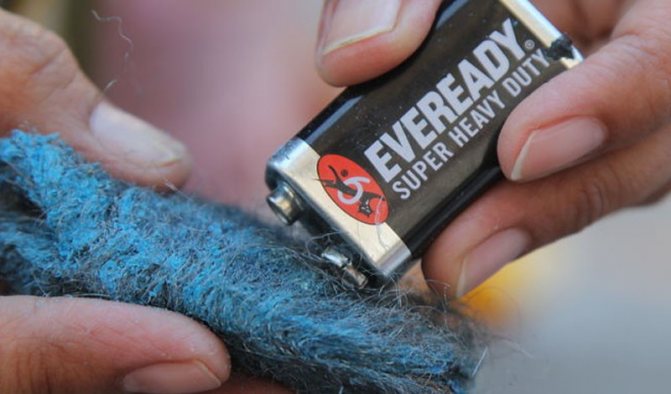
We simply stretch the woolen fabric (preferably the wool is natural) and quickly begin to rub a piece of wool with a battery. The optimal battery power suitable for such actions is approximately 9 W. After much effort, the wool slowly begins to ignite, all you have to do is blow lightly on it and add tinder to make the fire start faster.
If you find a fire in the forest
When relaxing in nature, it is important to remain vigilant, especially in the hot and dry season: even if you follow fire safety rules, you are not immune from disaster. An uncontrolled fire can be detected by the following signs:
- presence of a specific burning smell,
- a veil of smoke at an uncharacteristic time of day for fogs,
- disturbance of forest birds, insects, animals;
- mass movement of flocks of birds in one direction;
- the presence of glare of fiery glow on the horizon (at night).
The first action when a fire is detected is to immediately call firefighters or rescuers (telephone “112”)
If the flame is still weak and the ignition is local, you should try to extinguish it yourself:
- knock out the flames with a blanket, jacket, freshly broken branches of deciduous trees;
- pour water onto the fire;
- throw in wet turf;
- trample underfoot.
To extinguish a peat fire, you must:
- dig up the peat layer;
- Fill the soil with plenty of water.
When extinguishing a ground fire yourself, you should follow one of the basic rules of behavior in case of fire: step carefully on the ground, since there may be burnt-out layers of peat or deep craters under the ground.
Keep in mind that the speed of flame spread is high: when extinguishing a fire, do not move away from other people and stay in touch with each other, do not move away from an open clearing, pond or road.

Firearms
You can get life-saving fire if you have a firearm. The shot is simply removed from the cartridge itself, the cartridge case can be filled with tinder in the form of dry moss, leaves, rolled dry bark, and a blank shot can be fired at the place where the fire is planned. The rest is just a matter of technique, you need to fan the fire and throw dry branches into it.
A rather exotic method at first glance, but still very effective in emergency situations.
As you can see, there are many ways to start a fire if you don’t have matches. It is important to know some basic rules, folk tricks and tips that can keep you warm in the forest or even save your life if you suddenly get lost. Experience accumulated over centuries allows us to obtain life-saving fire from almost any available materials. This does not require special skill; it is important to apply the maximum amount of effort to make fire. Fire is life. And a cheerful, crackling fire will warm you in any situation and in any weather.
To avoid fire in the forest, it is prohibited
The period of increased fire danger in the forest is from May to September. During these months in the forest belt it is unacceptable:
- light an open fire for heating, cooking, or aesthetic purposes;
- smoking cigarettes or pipes;
- shoot a firearm;
- launch fireworks, use sparklers;
- refuel cars with gasoline;
- use equipment with a faulty engine;
- smoking near vehicles or industrial machines filled with flammable fuel;
- throw away glass objects (including bottles) - if they are exposed to direct sunlight, a fire may occur;
- burn grass or stubble on arable land near the forest belt.
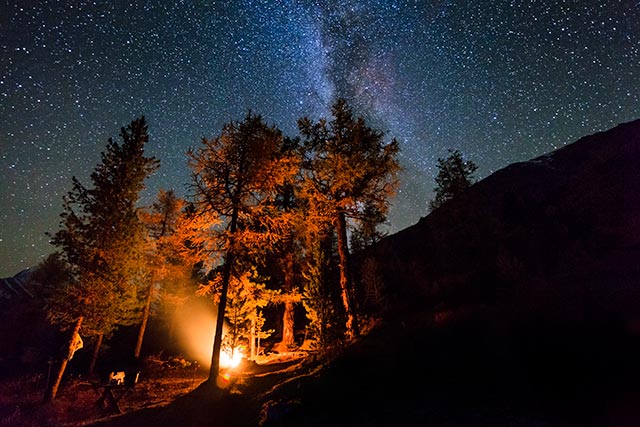
At any time of the year in the forest, the following requirements must be observed, which are the fundamentals of safe human life in the natural environment:
- throw unextinguished cigarettes or matches onto the ground;
- light an open fire near bushes, under the crowns of coniferous trees, near firewood or dead wood stores;
- throw easily flammable items: rags soaked in gasoline or oil, dry paper, bottles;
- make a fire during strong gusts of wind;
- use wads made of smoldering material to load hunting rifles;
- Fill the car's fuel tank with the engine not switched off.



